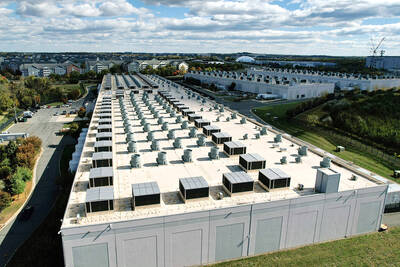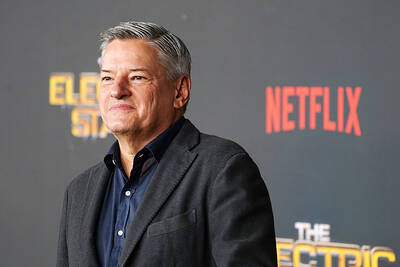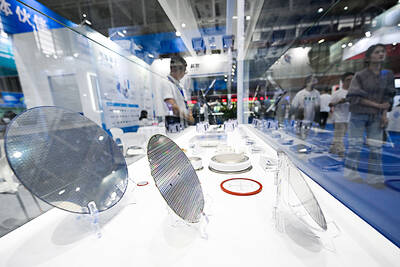They call it “the shrink” — it is the challenge of how to pack more circuits onto the microchips that power everything from our smartphones to our computers, even our coffee machines.
Pushing the boundaries of this technology is Dutch company ASML Holding NV, which since its foundation in 1984 has quietly become a world leader in the semiconductor business.
“There is more power in your smartphone today than was used to put man on the moon,” said ASML chief operating officer Frederic Schneider-Maunoury, animatedly waving his mobile phone in the air.
When you open an app on your smartphone, the chain allowing you to book a flight, message a friend or check out who is hot in your neighborhood most likely arcs all the way back to ASML.
Headquartered in Veldhoven, near the Belgian border, it builds sophisticated lithography machines to enable the world’s top chipmakers — Intel Corp, Samsung Electronics Co and Apple Inc supplier Taiwan Semiconductor Manufacturing Co (台積電) — to produce the smallest, most powerful and most cost-effective microprocessors on the planet.
Its newest machines use highly focused extreme ultra-violet (EUV) light to imprint designs on the chips, and are at the cutting edge of what is technologically possible in the art of miniaturization.
Last year, after two decades of research and development and billions of euros, ASML shipped its first 12 EUV machines to clients. Each costs about 120 million euros (US$143.53 million). This year, it has projected sales of 20 machines — by 2020, it hopes to be selling 35 to 40 a year.
It is ironic that these machines, which produce chips of infinitesimally small dimensions, are the size of a bus. Three Boeing 747 aircraft are needed to transport one machine to a client.
Long seen as a bellwether of the tech industry, the company is listed on the Amsterdam bourse, the AEX and the NASDAQ in New York.
Last year it announced profits had almost doubled to 2.12 billion euros on record sales of 9.05 billion euros.
Only two other companies in the world — the Japanese giants Nikon Corp and Canon Corp — make lithography machines and neither has yet developed EUV technology.
“Our problem is not just to find the technologies, we have to put it into the products in an economical way,” Schneider-Maunoury told reporters at his office.
ASML now employs about 20,000 people, mostly engineers and most in Veldhoven, but it also has sites in Asia and the US.
As it grows, it is hiring. About 3,000 new posts were added last year, with a similar number of new jobs expected this year.

The demise of the coal industry left the US’ Appalachian region in tatters, with lost jobs, spoiled water and countless kilometers of abandoned underground mines. Now entrepreneurs are eyeing the rural region with ambitious visions to rebuild its economy by converting old mines into solar power systems and data centers that could help fuel the increasing power demands of the artificial intelligence (AI) boom. One such project is underway by a non-profit team calling itself Energy DELTA (Discovery, Education, Learning and Technology Accelerator) Lab, which is looking to develop energy sources on about 26,305 hectares of old coal land in

Taiwan’s exports soared 56 percent year-on-year to an all-time high of US$64.05 billion last month, propelled by surging global demand for artificial intelligence (AI), high-performance computing and cloud service infrastructure, the Ministry of Finance said yesterday. Department of Statistics Director-General Beatrice Tsai (蔡美娜) called the figure an unexpected upside surprise, citing a wave of technology orders from overseas customers alongside the usual year-end shopping season for technology products. Growth is likely to remain strong this month, she said, projecting a 40 percent to 45 percent expansion on an annual basis. The outperformance could prompt the Directorate-General of Budget, Accounting and

Netflix on Friday faced fierce criticism over its blockbuster deal to acquire Warner Bros Discovery. The streaming giant is already viewed as a pariah in some Hollywood circles, largely due to its reluctance to release content in theaters and its disruption of traditional industry practices. As Netflix emerged as the likely winning bidder for Warner Bros — the studio behind Casablanca, the Harry Potter movies and Friends — Hollywood’s elite launched an aggressive campaign against the acquisition. Titanic director James Cameron called the buyout a “disaster,” while a group of prominent producers are lobbying US Congress to oppose the deal,

Two Chinese chipmakers are attracting strong retail investor demand, buoyed by industry peer Moore Threads Technology Co’s (摩爾線程) stellar debut. The retail portion of MetaX Integrated Circuits (Shanghai) Co’s (上海沐曦) upcoming initial public offering (IPO) was 2,986 times oversubscribed on Friday, according to a filing. Meanwhile, Beijing Onmicro Electronics Co (北京昂瑞微), which makes radio frequency chips, was 2,899 times oversubscribed on Friday, its filing showed. The bids coincided with Moore Threads’ trading debut, which surged 425 percent on Friday after raising 8 billion yuan (US$1.13 billion) on bets that the company could emerge as a viable local competitor to Nvidia